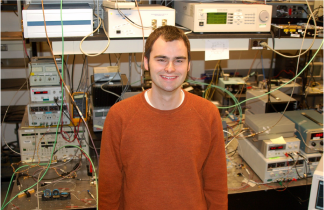 |
Wavelength Modulation Spectrum using tunable 2.0 micron VCSEL; From JTh1L.6, A. Kahn et al,. "Open-Path Green House Gas Sensor for UAV Applications"
|
-CM2B.2, "A Broadband 1850-nm 40-Gb/s Receiver Based on Four-Wave Mixing in Silicon Waveguides"
-CTu3M.7, "All-fiber 10-GHz Picosecond Pulse Generation at 1.9 microns without Mode-locking"
-JTh1L.6, "Open-Path Green House Gas Sensor for UAV Applications"
-CF1K.1, "Single-Frequency kHz-Linewidth 2-μm GaSb-Based Semiconductor Disk Lasers With Multiple-Watt Output Power"
-CF1N.4, "Double-wall carbon nanotube
Q-switched and Mode-locked Two-micron Fiber Lasers"
However, what we like to research and what we can actually bring to market are often two very different things. I am therefore excited that it is not just 2.0 micron papers that are cropping up at this years conference, but 2.0 micron products at the expo as well.
So why is anyone interested in light in the 2.0 micron region? My personal interest stems from a research talk I saw by analytical chemist, Mark Arnold, at University of Iowa. Arnold is trying to perform some hard analytical chemistry on 2.0 micron light shone through the skin on the back of one's hand. He hopes that by looking at the absorption spectra, he can measure blood glucose levels without having to draw blood. This noninvasive testing would be a boon to diabetics who are not thrilled about pricking their fingers regularly. Wavelengths that are helpful for pinning down glucose, but that are not absorbed as readily by tissue are 2.13 microns, 2.27 microns, and 2.33 microns.
In short, there are some interesting molecules around 2.0 microns on which to perform spectroscopy. For environmental sensing, there is 1877 nm, a well defined water absorption line, and 2004 nm, a good line for carbon dioxide detection, and many more.
Many of the companies I spoke with selling 2.0 micron components and sources confirmed such spectroscopic applications of their customers:
-Oz Optics now sells passive fiber components at 2.0 microns as well as DFB sources.
-Sacher Lasertchnik and Nanoplus make DFB lasers extending through the 2.0 micron region depending on your molecule of interest.
-Advalue Photonics makes thulium-based fiber laser systems and sells passive 2.0 micron products.
-New Focus will be developing tunable laser diodes about 2.0 microns in the next few months.
-Nufern and CorActive are selling Tm- and Ho-doped fiber for 2.0 micron amplification and for fiber sources.
-IPG sells a number of lasers from 2.0-2.8 microns based Cr:ZnSe as well as 2.0 micron fiber lasers using thulium doped fibers.
There are other advantages to 2.0 micron light as well. 2.2 microns is where the two-photon absorption coefficient in silicon drops to nothing. If you are interested in confining light to a silicon waveguide, doing so at 1550 nm could be the worst choice since it coincides with the peak two-photon absorption. However, above 2.2 microns allows higher throughput as well as access to other nonlinear effects like parametric amplification.
This is one of the pursuits of Thorlab startup, PicoLuz. Among other optical instrumentation, PicoLuz is developing 2.0 micron amplifiers which will eventually support its endeavors of a chip scale optical parametric amplification.
-Thorlab's Quantum electronics division is also selling a laser that is tunable about the gain bandwidth of thulium 1800-2000 nm, an FTIR spectrometer that goes out to 2500 nm, a handful of moderate speed long-wavelength detectors, passive fiber components for 2.0 microns, as well as pumps for Tm-amplifiers.
Another reason for generating 2.0 micron light is for opening up new spectral bandwidth for telecommunications or signal processing, whether on fiber or on silicon. To that end,
-Eospace is now offering 20 Gb/s speed LiNbO3 intensity and phase modulators at 2.0 microns.
-Electro-Optics Technology is pushing past 1 GHz speed for 2.0 micron detectors.
Malcom Minty, a project manager from New Focus told me that New Focus was actively persuing thulium based laser systems in the 90's. The thought was that bandwidth would all be used up in the C- and L-band during the telecom boom, requiring expansion. Thulium has wide efficient gain and was a natural choice. Nufocus dumped the project as the the telecom bubble burst. Now they will be rejuvenating it, but more likely to sell to customers interested in spectrscopic pursuits.
Minty conjectured that 2.0 microns is becoming an interesting color to customers, vendors and researchers because it is in a region (or getting close to a region) of spectrscopic and biomedical interest. However, because it is close enough to the L-band, much telecom technology can still be used. It just squeaks by with some efficiency for detection on InGaAs-based detectors where as detection methods above 3.0 microns start getting tricky.
I think Minty likely has this right. If so I will be interested to see what new research we can carryout with 2.0 micron light while leveraging what we already know from fiber systems and telecom.

No comments:
Post a Comment